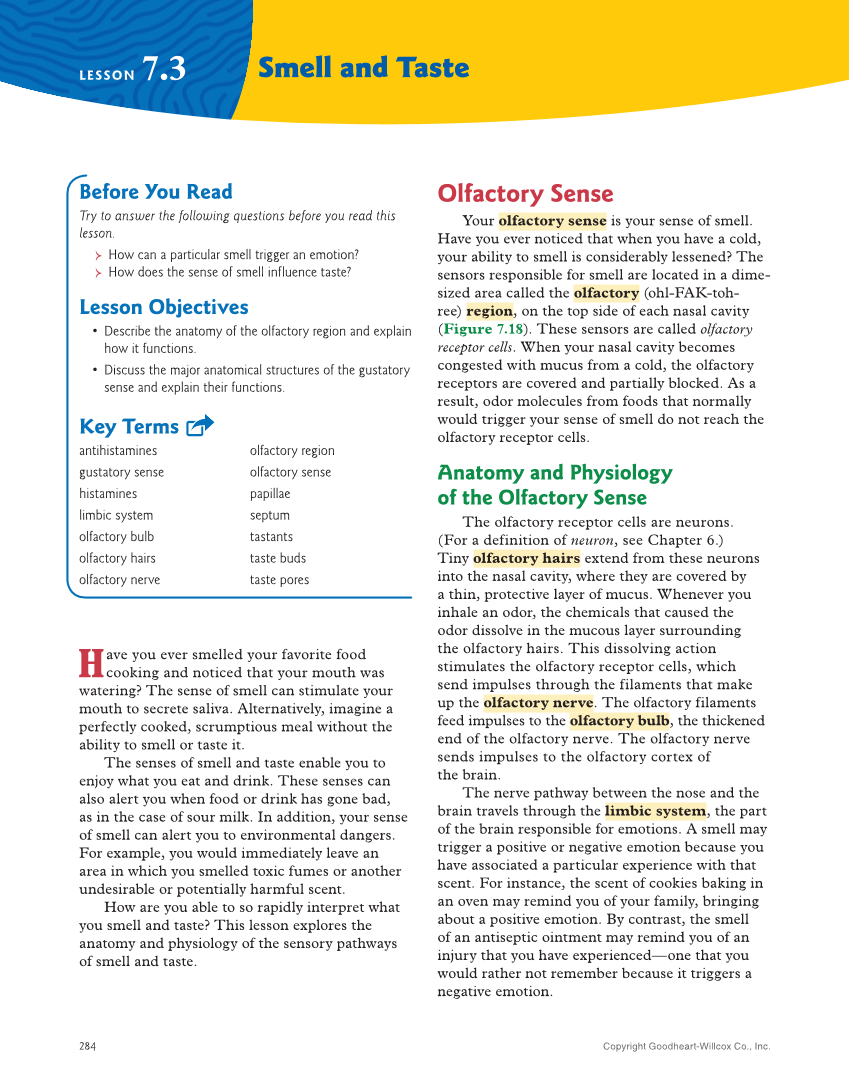284 Olfactory Sense Your olfactory sense is your sense of smell. Have you ever noticed that when you have a cold, your ability to smell is considerably lessened? The sensors responsible for smell are located in a dime- sized area called the olfactory (ohl-FAK-toh- ree) region, on the top side of each nasal cavity (Figure 7.18). These sensors are called olfactory receptor cells. When your nasal cavity becomes congested with mucus from a cold, the olfactory receptors are covered and partially blocked. As a result, odor molecules from foods that normally would trigger your sense of smell do not reach the olfactory receptor cells. Anatomy and Physiology of the Olfactory Sense The olfactory receptor cells are neurons. (For a definition of neuron, see Chapter 6.) Tiny olfactory hairs extend from these neurons into the nasal cavity, where they are covered by a thin, protective layer of mucus. Whenever you inhale an odor, the chemicals that caused the odor dissolve in the mucous layer surrounding the olfactory hairs. This dissolving action stimulates the olfactory receptor cells, which send impulses through the filaments that make up the olfactory nerve. The olfactory filaments feed impulses to the olfactory bulb, the thickened end of the olfactory nerve. The olfactory nerve sends impulses to the olfactory cortex of the brain. The nerve pathway between the nose and the brain travels through the limbic system, the part of the brain responsible for emotions. A smell may trigger a positive or negative emotion because you have associated a particular experience with that scent. For instance, the scent of cookies baking in an oven may remind you of your family, bringing about a positive emotion. By contrast, the smell of an antiseptic ointment may remind you of an injury that you have experienced—one that you would rather not remember because it triggers a negative emotion. Before You Read Try to answer the following questions before you read this lesson. How can a particular smell trigger an emotion? How does the sense of smell influence taste? Lesson Objectives • Describe the anatomy of the olfactory region and explain how it functions. • Discuss the major anatomical structures of the gustatory sense and explain their functions. Key Terms antihistamines gustatory sense histamines limbic system olfactory bulb olfactory hairs olfactory nerve olfactory region olfactory sense papillae septum tastants taste buds taste pores Have you ever smelled your favorite food cooking and noticed that your mouth was watering? The sense of smell can stimulate your mouth to secrete saliva. Alternatively, imagine a perfectly cooked, scrumptious meal without the ability to smell or taste it. The senses of smell and taste enable you to enjoy what you eat and drink. These senses can also alert you when food or drink has gone bad, as in the case of sour milk. In addition, your sense of smell can alert you to environmental dangers. For example, you would immediately leave an area in which you smelled toxic fumes or another undesirable or potentially harmful scent. How are you able to so rapidly interpret what you smell and taste? This lesson explores the anatomy and physiology of the sensory pathways of smell and taste. LESSON 7.3 Smell and Taste Copyright Goodheart-Willcox Co., Inc.
